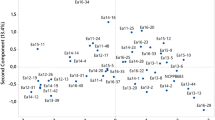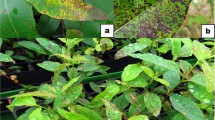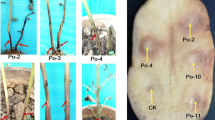Abstract
Black lesions on shoots of European pear trees observed in an orchard in Yamagata Prefecture in May 2007 were suspected to be caused by a bacterial pathogen. The surface of the colonies isolated on a high sucrose medium did not have the crater morphology that is characteristic of E. amylovora bvs. 1–3, and a specific DNA fragment was amplified from the isolates in the PCR using the EprpoD primer set. The partial sequences of the 16S rRNA gene placed the isolates in the genus Erwinia. The isolates differed serologically from E. amylovora biovars and E. pyrifoliae in an Ouchterlony double-diffusion test although their bacterial properties suggested that they are closely related to E. amylovora biovars and E. pyrifoliae. In a DNA–DNA hybridization test, the relatedness between the isolates and E. amylovora biovars or E. pyrifoliae did not exceed 70% level, indicating that they are independent species. Thus, the isolates belongs to the genus Erwnia but are not E. amylovra or E. pyrifoliae. After succulent pear shoots were injected with bacterial suspensions (109, 108, 107 and 106 cfu/ml) of the isolates, lesions formed with 109 and 108 cfu/ml, but the disease incidence with 108 cfu/ml was much lower than with E. amylovora and E. pyrifoliae. Virulence of the present isolates is thus thought to be very weak. On the basis of these results, we consider that this is a new shoot disease of European pear. In the 2007 season, all affected trees were pulled out after harvest. No symptoms have been observed in field surveys since the fruitlet season in 2007.






Similar content being viewed by others
References
Ausubel FM, Brent R, Kingston RE, Moore DD, Seidman JG, Smith JA, Struhl K (eds) (1988) Current protocols in molecular biology. Wiley, New York
Bereswill S, Pahl A, Belleman P, Zeller W, Geider K (1992) Sensitive and species-specific detection of Erwinia amylovora by polymerase chain reaction analysis. Appl Environ Microbiol 58:3522–3526
Ezaki T, Hashimoto Y, Yabuuchi E (1996) Fluorometric deoxyribonucleic acid–deoxyribonucleic acid hybridization in microdilution wells as an alternative to membrane filter hybridization in which radioisotopes are used to determine genetic relatedness among bacterial strains. Int J Syst Bacteriol 39:224–229
Guilford PJ, Taylor RK, Clark RG, Hale CN, Forster RLS (1996) PCR-based techniques for the detection of Erwinia amylovora. Acta Hortic 411:53–56
Johnson JL (1984) Bacterial classification. Nucleic acids in bacterial classification. In: Krieg NR (ed) Bergey’s manual of systematic bacteriology, vol 1. Williams and Wilkins, Baltimore, pp 8–11
Matsuura T, Azegami K, Inoue Y, Sasaki A, Shimane T, Mizuno A (2008) Phylogenic analyses of the fire blight pathogen and closely related bacteria and development of primer sets of based on phylogenic difference. Acta Hortic 793:149–153
Mizuno A, Sato S, Kawai A, Nishiyama K (2000) Taxonomic position of the causal pathogen of bacterial shoot blight of pear. J Gen Plant Pathol 66:48–58
Mizuno A, Sato S, Kawai A (2002a) Serological differences among Erwinia amylovora biovars. J Gen Plant Pathol 68:350–355
Mizuno A, Tsukamoto T, Kawai A (2002b) Detecting method of Erwinia amylovora from internal tissues of mature apple fruits (in Japanese). Res Bull Plant Prot Ser Jpn 38(Suppl):9–12
Mizuno A, Matsuura T, Shimizu Y, Uematsu H, Tsukamoto T, Saito N, Sato S, Kikuchi S, Uzuki T, Azegami K (2009) Occurrence of bacterial black shoot disease of European pear in Yamagata prefecture (abstract in Japanese). Jpn J Phytopathol 75:208
Suetsugu T, Sato S, Takayama M, Yamauchi A (1981) Studies on the diagnosis of foreign bacterial plant diseases of major plant quarantine II. Detection of Erwinia amylovora (in Japanese). Res Bull Plant Prot Jpn 17:77–85
Thompson JD, Higgins DG, Gibson TJ (1994) CLUSTAL_W: improving the sensitivity of progressive multiple sequence alignment through sequence weighting, position-specific gap penalties and weight matrix choice. Nucleic Acids Res 22:4673–4680
Tsukamoto T (2005) Diagnosis of fire blight and identification for Erwinia amylovora (in Japanese). In: Fallen leaf fruit tree research proceeding (plant disease section), pp 32–37
Wakimoto S (1967) Some characteristics of citrus canker bacteria, Xanthomonas citri (Hasse) Dowson, and the related phages isolated from Japan. Ann Phytopathol Soc Jpn 33:301–310
Acknowledgments
We thank Ms Y. Kumagai in Yokohama Plant Protection Station for her critical reading and valuable suggestions for the manuscript. We are grateful to Drs. T. Shimane, K. Yoshida and T. Ito, National Institute of Tree Fruit Science for providing immature fruits and scions for inoculation tests.
Author information
Authors and Affiliations
Corresponding author
Rights and permissions
About this article
Cite this article
Mizuno, A., Tsukamoto, T., Shimizu, Y. et al. Occurrence of bacterial black shoot disease of European pear in Yamagata Prefecture. J Gen Plant Pathol 76, 43–51 (2010). https://doi.org/10.1007/s10327-009-0215-8
Received:
Accepted:
Published:
Issue Date:
DOI: https://doi.org/10.1007/s10327-009-0215-8




